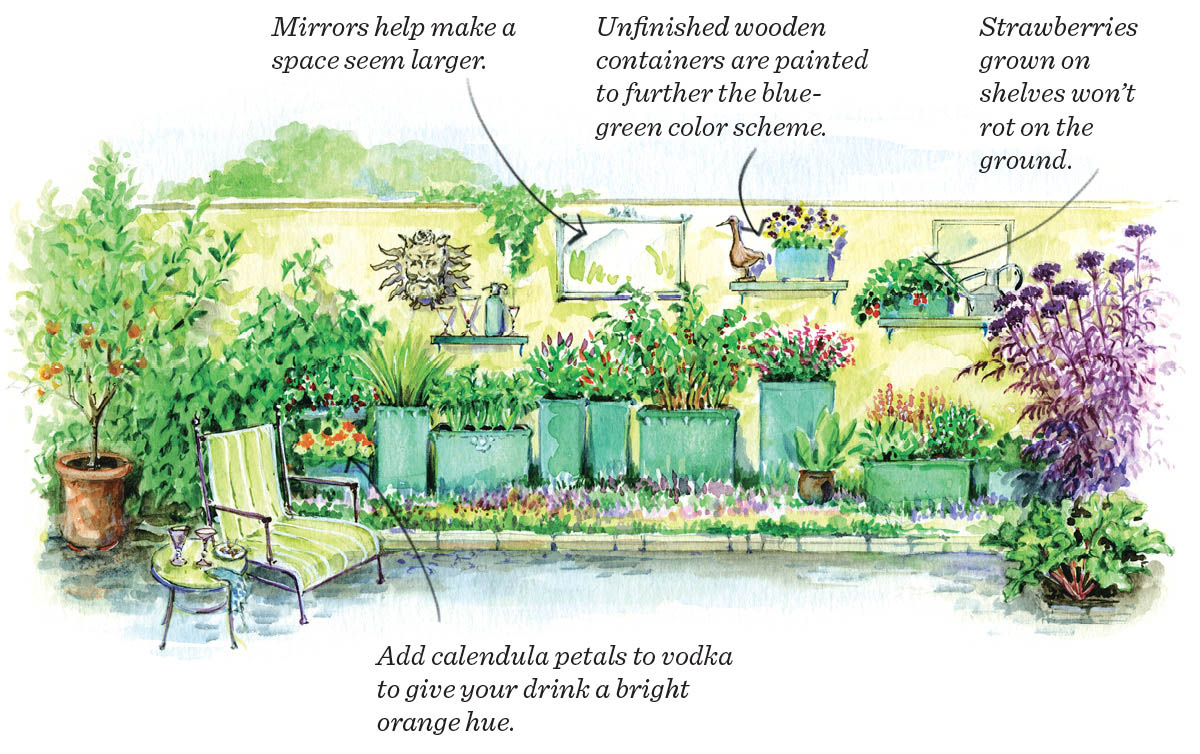
Cocktails anyone? After a long day at the office, a great way to relax and unwind is with a homegrown cocktail like The Herbarium or The Farmers’ Market (see here for recipes), especially if you enjoy them in the garden surrounded by the plants that provided the just-picked ingredients. This “Cocktail Garden” provides plenty of space for a range of cocktail-themed plants, cocktail accessories, and cozy seating for enjoying your just-mixed botanical beverages.
Amy Stewart is a writer who, when tackling a new project, immerses herself wholeheartedly in her research. She notes that the research for her latest project, The Drunken Botanist, involved “an in-depth exploration of the dizzying array of plants that humans have, through ingenuity, inspiration, and sheer desperation, contrived to transform into alcohol.” Part of her fieldwork required rigorous testing of dozens (and dozens) of recipes for a range of mixed drinks, which necessitated easy access to fresh ingredients like mint, strawberries, basil, and cucumbers. “This cocktail-themed garden got its start as a messy collection of plants in plastic pots arranged around my kitchen door,” recalls Amy.
Amy’s potpourri of cocktail-friendly plants soon expanded as more unusual specimens — black currants, sloe berries, hops, and elderflowers — found their way onto her doorstep. “That’s when I realized I needed a garden devoted exclusively to cocktail-friendly plants!” she exclaims. “I had two requirements: it had to be right off the kitchen, and it had to be a fun place to hang out.”
Fun setting. Amy enlisted the help of landscape designer Susan Morrison, who was able to envision the narrow strip next to her house — the majority of which is just 7 feet wide — as a place for both fun and functionality. For fun, she included decorative elements (mirrors and glass terrariums), a bar for crafting cocktails, and plenty of seating for party guests. “But it’s also a functional garden that accommodates my growing collection of edible mixers and garnishes,” adds Amy.
Designing with color. For the patio, Susan chose a concrete surface, edging it with narrow raised beds and an assortment of round and square pots. Before any materials were purchased, Susan and Amy set the color palette to keep the garden cohesive. “The majority of the containers are made from unfinished wood which is then painted, making it easy to repeat the blue-green color scheme throughout the space,” explains Susan.

Designing with shapes. Many of the pots are tall and narrow, which is ideal in a garden like Amy’s, as their slim profile means the plants in the containers won’t spill into the pathway and restrict foot traffic. Susan recommends that containers be at least 28 inches tall and 14 inches wide to allow plenty of room for roots to grow.
The larger pots on the patio are home to the more sizable plants like the columnar apple trees, which could be substituted with dwarf varieties if the site offered more in-ground space. In The Drunken Botanist, Amy points out that the first alcoholic concoction to come from apples was cider.
Planting on shelves. With the blank wall, Susan saw an opportunity to grow more plants for garnishes and mixers, as well as a convenient spot to display decorative pieces like mirrors, artwork, and vintage windows. “Mirrors and ‘windows’ can help make a space seem larger,” says Susan. “Planters on the walls add additional growing space and are perfect for shallow-rooting edibles such as herbs and strawberries.” In fact, Amy prefers to grow strawberries vertically, so that the berries won’t turn to mush on the ground. Nearby shelving offers additional space for Amy’s potted plants, decorative piece, or “cocktail accoutrements,” laughs Susan, who notes that Amy added drainage holes to the shelves so they can be easily hosed down.
The majority of Amy’s botanical beverage plants are easily grown in pots. Some are obvious choices — mint, celery, lemon verbena — while calendula, cilantro, and lavender are slightly less conventional. Calendula, for example, has pretty petals that can be sprinkled into glasses as a garnish, adding a jolt of color to mixed drinks. “The advantage of calendula is that it isn’t colorfast — so the bright orange hue will actually seep into vodka or simple syrup,” says Amy.
When buying seedlings to use as mixers or garnishes, look for plants that were grown organically. Of course, you can also start your own from seed.
Here are a couple of Amy’s killer cocktails. Pick a few vegetables and herbs, combine them with some spirits, and sip comfortably in your garden.
Squeeze lemon into cocktail shaker and add the gin and elderflower liqueur. Muddle cucumber and basil and add to shaker. Add ice, shake, and strain into a tall, skinny Collins glass filled with ice. Top with club soda and garnish.
Reserve a celery stalk, cherry tomato, or cucumber for garnish. Combine the vodka, cucumbers, celery, cilantro, peppers, tomatoes, and Worcestershire sauce in a cocktail shaker. Gently crush the vegetables and herbs, making sure to release the juice from the tomatoes. Add ice, shake, and strain into a tumbler filled with ice. Top with tonic water and add garnish.
